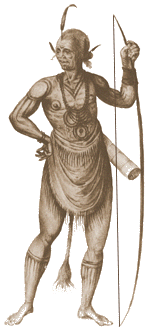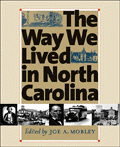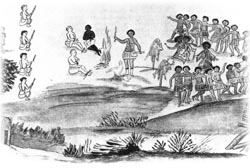
Tuscarora Indian.
|



THE TUSCARORA WAR . . .
CHAPTER EXCERPTS
 or years, the Tuscaroras, an agricultural tribe related to the Iroquois, had inhabited the North Carolina Coastal Plain west of the Algonquians. According to one early eighteenth-century report, the Tuscaroras lived in fifteen different villages scattered throughout the Pamlico and Neuse River drainage basins. By the 1670s the Tuscaroras were aware that the Albemarle settlement was overspilling its bounds and the colonial government was extending its control southward. Immigrants by the hundreds invaded Tuscarora territory. or years, the Tuscaroras, an agricultural tribe related to the Iroquois, had inhabited the North Carolina Coastal Plain west of the Algonquians. According to one early eighteenth-century report, the Tuscaroras lived in fifteen different villages scattered throughout the Pamlico and Neuse River drainage basins. By the 1670s the Tuscaroras were aware that the Albemarle settlement was overspilling its bounds and the colonial government was extending its control southward. Immigrants by the hundreds invaded Tuscarora territory.
Although the circumstances leading up to the war were manifold, John Lawson put the situation quite plainly in his observation on relations with the Indians of the previous decade: "They are really better to us than we are to them; they always give us Victuals at their Quarters, and take care we are arm'd against Hunger and Thirst: We do not do so by them (generally speaking) but let them walk by our Doors Hungry, and do not often relieve them." Specifically, the outbreak of hostilities can be narrowed down to three Indian grievances: the practices of white traders, Indian enslavement, and, most important, land encroachment.

John Lawson, Christoph von Graffenried, and a black slave held captive by the Tuscarora, as sketched by Graffenried. The Indians tortured and killed Lawson but released von Graffenried and the slave.
|
Unable to find refuge in Pennsylvania, the Tuscaroras took the offensive. In early September 1711 the Tuscaroras captured Baron von Graffenried, John Lawson, and two black slaves as they journeyed up the Neuse River. The Indians took their prisoners to the village of Catechna, about four miles north of present-day Grifton, in Pitt County. At Catechna, John Lawson quarreled heatedly with a Coree chief named Cor Tom. In response, the Indians tortured and killed Lawson. Graffenried was more diplomatic and lived to describe the experience in word and picture. Known for harboring black fugitives, the Tuscaroras spared the slaves. Lawson had been dead little more than a decade when William Byrd wrote, "they [the Indians] resented their wrongs a little too severely upon Mr. Lawson, who, under Colour of being Surveyor Gen'l, had encroacht too much upon their Territories, at which they were so enrag'd, that they . . . cut his throat from Ear to Ear, but at the same time releas'd the Baron de Graffenried, whom they had Seized for Company, because it appear'd plainly he had done them no Wrong."
West of the present-day town of Snow Hill in Greene County the Tuscaroras' determined struggle to retain their homeland was brought to an end. Here, on 20 March 1713, Moore's forces began their attack on Fort Neoheroka. For three days the Tuscaroras withstood the South Carolina Indian onslaught. Finally Moore's forces set fire to the bastions and to buildings within the Tuscarora stronghold. By mid-morning on 23 March they had routed the last of its Indian defenders.
|

